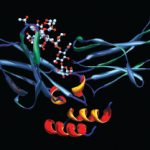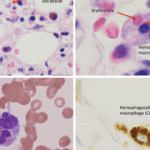Despite its rarity, cutaneous T cell lymphoma should be considered in DM patients presenting with such skin findings as atypical plaques, nodules, ulcerations & tumor formation.
Screening guidelines for DM patients are needed for practicing rheumatologists. In a cohort of DM patients, it was found that age-appropriate cancer screening is not aggressive enough. In addition to your usual malignancy screening, computerized tomography of the chest, abdomen and pelvis also aid in a malignancy diagnosis.7 Features that should prompt investigation for malignancy include refractoriness to treatment, older age, leukocytoclastic vasculitis, severe muscle disease, low C4, cytopenias and hyperimmunoglobulinemia.3
Certain myositis-specific antibodies, such as anti-nuclear matrix protein-2 (anti-NXP-2) antibody and anti-transcriptional intermediary factor 1 γ (anti-TIF1γ) antibody, are associated with malignancy, but anti-Mi-2 antibodies are not. In a large cohort of malignancy-associated DM, 83% of patients were found with either anti-TIF1γ or anti-NXP-2 antibodies. Patients with either antibody had an increased risk of developing malignancy, with an odds ratio of 3.8.11 Anti-Mi-2 antibodies are associated with classic cutaneous DM, lower interstitial lung disease risk, milder muscle disease and good treatment response. Anti-NXP-2 antibodies are associated with juvenile DM, calcinosis and severe disease. Anti-TIF1γ antibodies are associated with early diagnosis of malignancy, severe cutaneous disease and ulcerations.12
Our case highlights the importance of heightened surveillance in DM patients despite the type of biomarkers present.12
 Barrett Ford, MD, is a fellow in the Section of Rheumatology at the Louisiana State University Health Sciences Center, New Orleans.
Barrett Ford, MD, is a fellow in the Section of Rheumatology at the Louisiana State University Health Sciences Center, New Orleans.
 Chandana Shilpa Kollipara Ravipati, DO, is an assistant professor of clinical medicine in the Section of Rheumatology at Louisiana State University Health Sciences Center.
Chandana Shilpa Kollipara Ravipati, DO, is an assistant professor of clinical medicine in the Section of Rheumatology at Louisiana State University Health Sciences Center.
 Nirupa Patel, MD, is an associate professor of clinical medicine in the Section of Rheumatology at the Louisiana State University Health Sciences Center.
Nirupa Patel, MD, is an associate professor of clinical medicine in the Section of Rheumatology at the Louisiana State University Health Sciences Center.
References
- Bhatty O, Sen R, Nahas J. Cancer-associated myositis: A case report & review of the literature. Rheumatologist. 2019;59.1–7.
- Hill CL, Zhang Y, Sigurgeirsson B, et al. Frequency of specific cancer types in dermatomyositis and polymyositis: A population-based study. Lancet. 2001 Jan 13;357(9250):96–100.
- Yi L, Qun S, Wenjie Z, et al. The presenting manifestations of subcutaneous panniculitis-like T-cell lymphoma and T-cell lymphoma and cutaneous Y8 T-cell lymphoma may mimic those of rheumatic diseases: A report of 11 cases. Clin Rheumatol. 2013 Aug;32(8):1169–1175.
- Connor B. Mycosis fungoides with dermatomyositis. Proc R Soc Med. 1972 Mar;65(3):251–252.
- Yang Z, Lin F, Qin B, et al. Polymyositis/dermatomyositis and malignancy risk: A metaanalysis study. J Rheumatol. 2015 Feb;42(2):282–291.
- Kojima M, Nakamura S, Futamura N, et al. Malignant lymphoma in patients with rheumatic diseases other than Sjögren’s syndrome: A clinicopathologic study of five cases and a review of the Japanese literature. Jpn J Clin Oncol. 1997 Apr;27(2):84–90.
- Leatham H, Schadt C, Chisolm S, et al. Evidence supports blind screening for internal malignancy in dermatomyositis: Data from 2 large US dermatology cohorts. Medicine (Baltimore). 2018 Jan;97(2):e9639.
- Fujii K. New Therapies and Immunological Findings in Cutaneous T-Cell Lymphoma. Front Oncol. 2018 Jun 4;8:198.
- Kim YH, Chow S, Varghese A, et al. Clinical characteristics and long-term outcome of patients with generalized patch and/or plaque (T2) mycosis fungoides. Arch Dermatol. 1999 Jan;135(1):26–32.
- PDQ Adult Treatment Editorial Board. Mycosis Fungoides (Including Sézary Syndrome) Treatment—Health Professional Version. Bethesda, MD: National Cancer Institute. Updated 2019 Sep 20.
- Fiorentino DF, Chung LS, Christopher-Stine L, et al. Most patients with cancer-associated dermatomyositis have antibodies to nuclear matrix protein NXP-2 or transcription intermediary factor 1Y. Arthritis Rheum. 2013 Nov;65(11):2954–2962.
- Gunawardena H, Betteridge ZE, McHugh NJ. Myositis-specific autoantibodies: Their clinical and pathogenic significance in disease expression. Rheumatology (Oxford). 2009 Jun;48(6):607–612.

